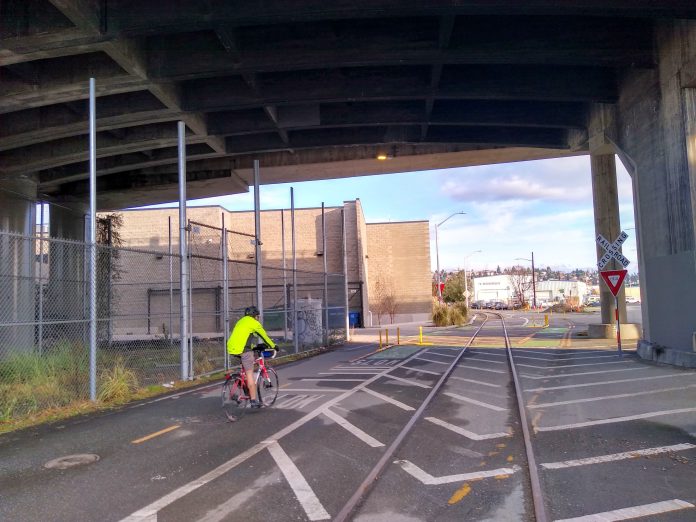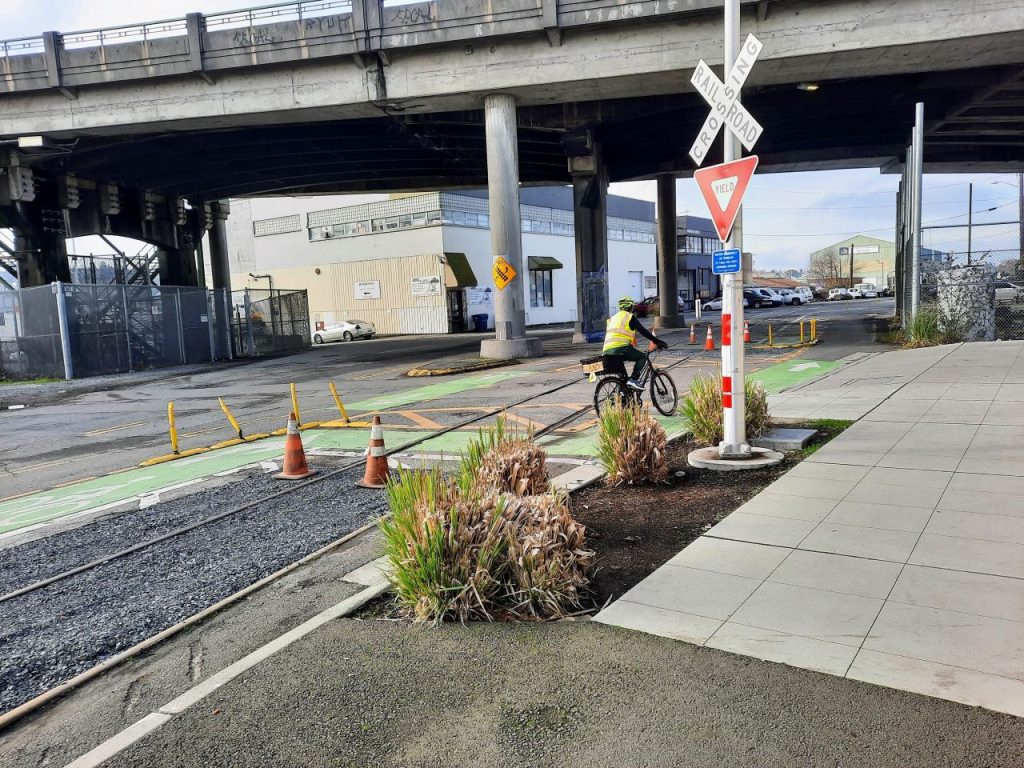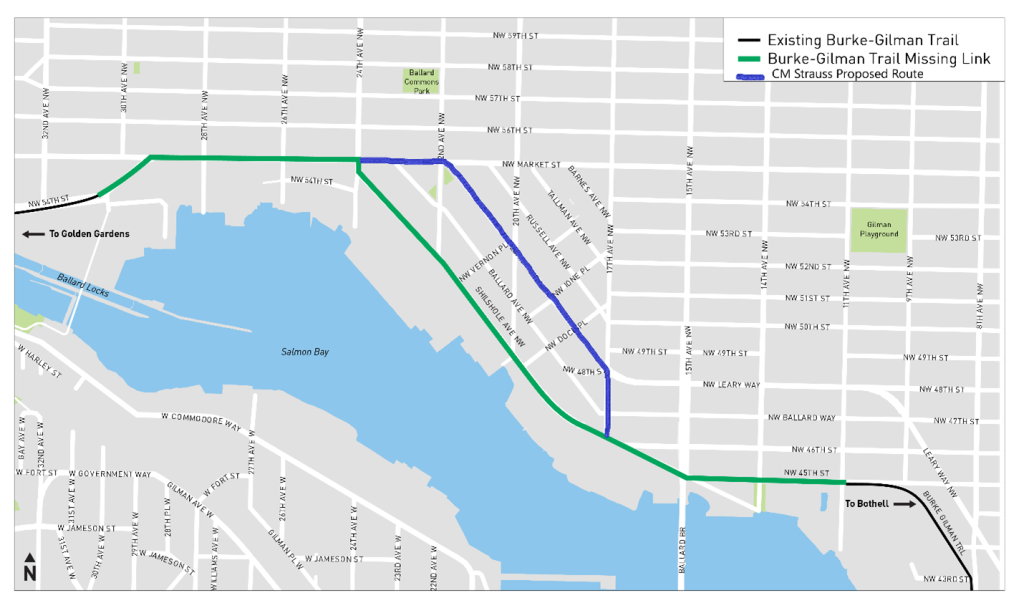
One of the city’s most dangerous places to ride a bike could get significantly safer in just a few short weeks — if quick action by the Seattle City Council proposed this week is able to move forward. The area in question is directly under the Ballard Bridge at a stretch of railroad embedded in the roadway that since 1997 has been operated under an agreement with the city by the Ballard Terminal Railroad. These railroad tracks are the greatest safety hazard for the long-problematic “Missing Link” stretch of the Burke-Gilman Trail, and they have led to innumerable serious injuries over the past decades.
As part of legislation being fast-tracked during the council’s budget season by Councilmember Dan Strauss, jurisdiction of the entire stretch of tracks in industrial Ballard would be transferred from the Ballard Terminal Railroad (BTRR) to the Southern Meeker Railroad. After that occurs, the Seattle Department of Transportation (SDOT) will quickly move to pave over the stretch of tracks under the Ballard Bridge that have long proven to be a public hazard. One element of urgency here is weather-related, with SDOT’s goal being to put the asphalt in place before freezing temperatures which would postpone work.
An SDOT spokesperson confirmed that under the existing franchise agreement, set to be transferred, the BTRR will allow the City to pave over the section of track that is underneath the bridge. “Our pavement and traffic engineers are in the process of finalizing some design refinements based on several factors including drainage needs,” the statement noted. “We will be able to share an image of the paved area within the next couple days. However, the paved-over track segment is largely intended to cover the railroad track segment beneath the Ballard Bridge.”
The Seattle City Council is set to consider the ordinance setting this in motion at its October 24 council meeting. It will skip the normal committee review process and come directly before all nine councilmembers on a fairly compressed timeline.

It’s still not fully clear why the operators of the Ballard Terminal Railroad are agreeing to forego future use of a segment of their asset in exchange for city’s approval of a change in ownership, but the answer is likely related to significant amount of litigation — and high insurance costs — that come with the current street configuration. A new entity in control of the tracks could start fresh… if the City is able to keep the area under the bridge safe in the long-term.
The railroad would still be able to maintain operations west of 15th Avenue NW, where the primary client it services, Salmon Bay Sand and Gravel, is located.
“This is a coming together moment,” Councilmember Strauss said on Tuesday as he introduced the bill, the exact text of which is still not public. “Of parties that typically disagree, we have found agreement here… It is important that we pass this as soon as possible to make biking in our city safer.”

“This is a big win, and it’s by no means close to done,” Lee Lambert, the Executive Director of Cascade Bicycle Club told The Urbanist. “We are excited about this being safer, because it’s covering the part of the track that are most dangerous, and we need to complete the Missing Link section at Shilshole so that people riding bikes are safe.”
Cascade has spent years in court with the City seeking to resolve the larger legal dispute that has kept the final segment of the Burke-Gilman Trail from being built on Shilshole Avenue NW. The Ballard Terminal Railroad has been on the other side of most of those legal disputes.
Strauss recently received buy-in from the Harrell administration to move forward with exploring a potential alternate design for the Missing Link that skips most of Shilshole Avenue and instead is routed onto 17th Avenue NW, Leary Avenue NW, and NW Market Street. That route has been long-preferred by business owners in industrial Ballard, like CSR Marine, that have been involved in the ongoing litigation. But either route will rely on Shilshole underneath the Ballard Bridge.

The City’s agreement with the railroad indemnifies the City against any liability stemming from injuries that occur on the tracks. However, a number of lawsuits have been filed over the years, not only to secure damages, but also to get the City to finally fix the dangerous stretch; the most recent one was filed just days ago. That suit, filed by Washington Bike Law, joins others that the firm has filed that have produced a settlement agreement that requires the City to make changes to the area by the end of the year — another element of urgency surrounding this move.
While the settlement agreement forced the City to modify the crossing to reduce the hazard, SDOT’s initial steps to adhere in January involved adding gravel pits and sharp turns that were not well-received by the bicycling community given the awkward geometry and slip hazard of the gravel.
“We are not ready to declare victory in this decades-long struggle,” Bob Anderton, Washington Bike Law’s founding attorney, said when reached for comment. “People are still regularly crashing in the Crash Zone, and the City’s initial step of adding of gravel pits appears to have made a dangerous street even more treacherous.”
Repaving the tracks may seem like a permanent solution at first glance, but as is the case with other abandoned tracks elsewhere in the city, asphalt can become quickly worn away and tracks re-exposed. Permanent removal of the tracks, the absolute safest option, doesn’t appear to be on the table right now, given that the Southern Meeker Railroad would still retain ownership of the tracks. But this could be an effective way to finally put an end to serious injuries along this infamous stretch.
“We do not want additional reasons to sue the City; we want to make up for the harm done to our clients and, with their authorization, to finally achieve action so that no one else is seriously injured or killed in the Missing Link’s Crash Zone,” Anderton said. “Hopefully paving over the tracks will be done soon and done right.”
Ryan Packer has been writing for The Urbanist since 2015, and currently reports full-time as Contributing Editor. Their beats are transportation, land use, public space, traffic safety, and obscure community meetings. Packer has also reported for other regional outlets including Capitol Hill Seattle, BikePortland, Seattle Met, and PubliCola. They live in the Capitol Hill neighborhood of Seattle.


